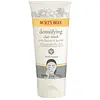What's inside
What's inside
 Key Ingredients
Key Ingredients

 Benefits
Benefits

 Concerns
Concerns

 Ingredients Side-by-side
Ingredients Side-by-side

Water
Skin ConditioningKaolin
AbrasiveBentonite
AbsorbentSimmondsia Chinensis Seed Oil
EmollientSulfur
AntiseborrhoeicEmulsifying Wax Nf
Butyrospermum Parkii Butter
Skin ConditioningSodium Stearoyl Lactylate
EmulsifyingButyl Avocadate
Skin ConditioningSalix Alba Bark Extract
AstringentGlycerin
HumectantBenzyl PCA
HumectantSalicylic Acid
MaskingPhytosterols
Skin ConditioningPanthenol
Skin ConditioningAscorbic Acid
AntioxidantTocopherol
AntioxidantBisabolol
MaskingMelaleuca Alternifolia Leaf Oil
AntioxidantDehydroacetic Acid
PreservativeAllantoin
Skin ConditioningTamarindus Indica Extract
SmoothingOlea Europaea Fruit Oil
MaskingMentha Spicata Flower/Leaf/Stem Oil
MaskingMentha Piperita Oil
MaskingEucalyptus Globulus Oil
Water, Kaolin, Bentonite, Simmondsia Chinensis Seed Oil, Sulfur, Emulsifying Wax Nf, Butyrospermum Parkii Butter, Sodium Stearoyl Lactylate, Butyl Avocadate, Salix Alba Bark Extract, Glycerin, Benzyl PCA, Salicylic Acid, Phytosterols, Panthenol, Ascorbic Acid, Tocopherol, Bisabolol, Melaleuca Alternifolia Leaf Oil, Dehydroacetic Acid, Allantoin, Tamarindus Indica Extract, Olea Europaea Fruit Oil, Mentha Spicata Flower/Leaf/Stem Oil, Mentha Piperita Oil, Eucalyptus Globulus Oil
Water
Skin ConditioningKaolin
AbrasiveGlycerin
HumectantMagnesium Aluminum Silicate
AbsorbentXanthan Gum
EmulsifyingParfum
MaskingLauryl Glucoside
CleansingHelianthus Annuus Seed Oil
EmollientCharcoal Powder
AbrasiveEuterpe Oleracea Fruit Oil
Skin ConditioningLonicera Japonica Flower Extract
Skin ConditioningLonicera Caprifolium Flower Extract
PerfumingPolymnia Sonchifolia Root Juice
Skin ConditioningLactobacillus
Skin ConditioningCitric Acid
BufferingTocopherol
AntioxidantMaltodextrin
AbsorbentPolyglycerin-10
HumectantPolyglyceryl-10 Myristate
Skin ConditioningPolyglyceryl-10 Stearate
Skin ConditioningSodium Dehydroacetate
PreservativeAlpha-Glucan Oligosaccharide
CleansingPhenoxyethanol
PreservativeLimonene
PerfumingLinalool
PerfumingWater, Kaolin, Glycerin, Magnesium Aluminum Silicate, Xanthan Gum, Parfum, Lauryl Glucoside, Helianthus Annuus Seed Oil, Charcoal Powder, Euterpe Oleracea Fruit Oil, Lonicera Japonica Flower Extract, Lonicera Caprifolium Flower Extract, Polymnia Sonchifolia Root Juice, Lactobacillus, Citric Acid, Tocopherol, Maltodextrin, Polyglycerin-10, Polyglyceryl-10 Myristate, Polyglyceryl-10 Stearate, Sodium Dehydroacetate, Alpha-Glucan Oligosaccharide, Phenoxyethanol, Limonene, Linalool
Ingredients Explained
These ingredients are found in both products.
Ingredients higher up in an ingredient list are typically present in a larger amount.
Glycerin is already naturally found in your skin. It helps moisturize and protect your skin.
A study from 2016 found glycerin to be more effective as a humectant than AHAs and hyaluronic acid.
As a humectant, it helps the skin stay hydrated by pulling moisture to your skin. The low molecular weight of glycerin allows it to pull moisture into the deeper layers of your skin.
Hydrated skin improves your skin barrier; Your skin barrier helps protect against irritants and bacteria.
Glycerin has also been found to have antimicrobial and antiviral properties. Due to these properties, glycerin is often used in wound and burn treatments.
In cosmetics, glycerin is usually derived from plants such as soybean or palm. However, it can also be sourced from animals, such as tallow or animal fat.
This ingredient is organic, colorless, odorless, and non-toxic.
Glycerin is the name for this ingredient in American English. British English uses Glycerol/Glycerine.
Learn more about GlycerinKaolin is a clay. It is used for oil control and to help minimize pores. Like other clays, kaolin has the ability to absorb excess sebum or oil. This can help clean out pores and mattify the skin.
Some types of kaolin may have exfoliating properties. When water is added to kaolin, it becomes a paste with small abrasive particles.
Most kaolin is a white color, but may be pink/orange/red depending on where it comes from.
The name 'kaolin' comes from a Chinese village named 'Gaoling'. Kaolin clay comes from rocks rich in kaolinite. Kaolinite, the mineral, has a silicate layered structure. Kaolinite is formed from chemical weathering of aluminum siilicate minerals.
Besides skincare, kaolin is commonly used to make glossy paper, in ceramics, toothpaste, and as medicine to soothe stomach issues.
Learn more about KaolinTocopherol (also known as Vitamin E) is a common antioxidant used to help protect the skin from free-radicals and strengthen the skin barrier. It's also fat soluble - this means our skin is great at absorbing it.
Vitamin E also helps keep your natural skin lipids healthy. Your lipid skin barrier naturally consists of lipids, ceramides, and fatty acids. Vitamin E offers extra protection for your skin’s lipid barrier, keeping your skin healthy and nourished.
Another benefit is a bit of UV protection. Vitamin E helps reduce the damage caused by UVB rays. (It should not replace your sunscreen). Combining it with Vitamin C can decrease sunburned cells and hyperpigmentation after UV exposure.
You might have noticed Vitamin E + C often paired together. This is because it is great at stabilizing Vitamin C. Using the two together helps increase the effectiveness of both ingredients.
There are often claims that Vitamin E can reduce/prevent scarring, but these claims haven't been confirmed by scientific research.
Learn more about TocopherolWater. It's the most common cosmetic ingredient of all. You'll usually see it at the top of ingredient lists, meaning that it makes up the largest part of the product.
So why is it so popular? Water most often acts as a solvent - this means that it helps dissolve other ingredients into the formulation.
You'll also recognize water as that liquid we all need to stay alive. If you see this, drink a glass of water. Stay hydrated!
Learn more about Water